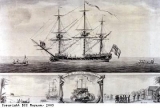Ships and shipping
Slaving voyages from Bristol were organised by businessmen who invested in the transatlantic slave trade . In order to make a profit they would send ships to Africa to trade for enslaved Africans, and take those Africans to be sold in the Caribbean and North America. To make a profit on their investment, those involved would have to organise the slaving voyages carefully as many disasters could affect a ship, such as bad weather, sickness of crew and slaves, not to mention slave rebellion.
Pictured here is the Bristol slave ship the Jason. On her one recorded slaving voyage in 1748, she carried 70 crew to look after the 600 slaves. Only 340 slaves survived the voyage to Jamaica, in the Caribbean. This could have been due to a number of reasons. Lives could have been lost due to sickness, slaves committing suicide, or poor treatment by the crew.
Slaving voyages were considered to be very high risk, however the possible profits to be gained were also high and many were willing to take the chance.




